|
This three-film Blu-ray set from Eureka is, in essence, a follow-up to last year’s six-movie Karloff at Columbia set. Again it consists of less widely discussed films in which Karloff appears, but this time the titles in question were all released by Universal, the studio with which the actor first found international fame and recognition. He headlines all three films but in truth is the lead player in only one, at least in terms of his screen time and the role his character plays in the story. These are three very different films from three separate decades, and while they all have their pleasures, for me they make for a somewhat uneven collection. Personal taste really played its part here, particularly in the case of the second title, but the best of the bunch is a bit of a belter. I will note, however, that the title of the set suggests it consists of three horror movies, which is just a little misleading, despite the role that horror does indeed play in two of the films.
To this day, Boris Karloff is known primarily for his horror roles, but once the popularity of horror as a genre began to fade, he began playing more kindly and sympathetic characters. These include several in which he is cast as a (sometimes ageing) scientist or doctor who has made a potentially momentous discovery, one that has occasionally driven him mad. If you made your way through the films in the abovementioned Karloff at Columbia set alone, you’ll have seen him play Dr Henryk Savaard in The Man they Could Not Hang (1939), Dr Kravaal in The Man With Nine Lives (1940), Dr John Garth in Before I Hang (1940), Dr Julian Blair in The Devil Commands (1941), and he even played the concept for laughs as Professor Nathaniel Billings in The Boogie Man Will Get You (1942). In the 1937 Night Key, he plays David Mallory, an engineer whose invention for a commercial security alarm system was stolen by his former friend and partner Stephen Ranger (Samuel S Hinds), apparently out of jealousy after David married the woman that Ranger was also in love with. Now David has developed a new wireless security device, and when Ranger learns that it could render the technology his company is based around redundant, he offers to let bygones be bygones and buy the new system from David on his requested terms. On hearing this news from his lawyer, Kruger (Edwin Maxwell), David tells his pretty adult daughter Joan (Jean Rogers) that their troubles are over. No more penny-pinching for us, they reason, as we’ll soon be rich! Oh, do you reckon?
We’re clued into the fact that the deal is doomed even before David and Ranger meet by the revelation that the man who brokered the deal, the aforementioned Kruger, is actually on Ranger’s payroll. The two have colluded to word the contract in a way that will allow Ranger to buy the product for a nominal fee but then never install a single unit, robbing David of his expected royalties whilst simultaneously preventing him from taking the invention to a rival firm. And time is running out for David, whose fading sight has deteriorated to the level where he is unable to see anything clearly without his glasses. Thus, when David enters Ranger’s office the atmosphere is friendly, and the contract is signed. Only then does Ranger reveal his intention to bury an invention that David has been working on for 15 long years, while Kruger makes a false display of being outraged by this exploitation of a small contract clause. As an utterly crestfallen David departs, he pauses to offer Ranger an ominous warning. “What I create,” he tells him, “I can destroy.”
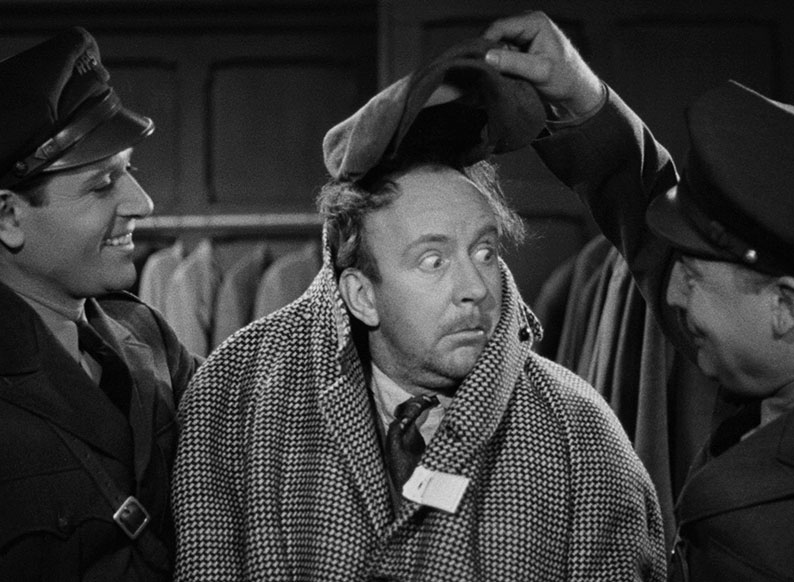
Running parallel to this story is one involving small-time thief Petty Louie (Hobart Cavanaugh), who is unfortunate enough to break into a tailor’s store that’s only recently been fitted with the Ranger system. Responding to the alarm is handsome young security operative Jim Travers (Warren Hull) and his partner Mike Callahan (David Oliver), who immediately recognise Louie and apprehend him. Instead of turning him into the police, they take him first to Ranger, whose immediate reaction is one of disappointment. It turns out that Louie is the ten-thousandth felon that the system has caught, something Ranger has planned a big press event to mark. “Why couldn’t you have been a big-time crook?” he asks Louie in exasperation. “I’ve asked myself that question a hundred times,” Louie replies. “I think I’m shy.”
The two stories collide when David leaves Ranger’s office and passes the cell in which Louie is being held. It’s here that David gets to demonstrate an electronic key he has constructed that can be tuned to the frequency used by the Ranger security system, preventing it from activating when an alarmed door is open. Quite why he originally built this is anybody’s guess, but he uses it to free Louie, and to write his parting message to Ranger on the holding cell wall as a declaration of war. Louie pesters David partner up with him – oh, the stores he could rob with David and his key – but David assures him that he not interested. When the spectacles on which David relies are knocked off and crushed by passing cars while he is crossing the road, however, he is forced to rely on Louie to see him home. By then, both Louie’s disappearance and David’s message have been discovered by Ranger and his team. Jim and Mike are dispatched to apprehend David at his lodgings, but before they can even knock on the door, Louie alerts David and helps him flee down the fire escape. As the search for the pair becomes a top priority, David enlists Louie’s help to repeatedly undermine the security system that he designed, putting increasing pressure on Ranger to make good on their original deal.
There’s a lot to like in Night Key, but also a sprinkling of overly familiar tropes, suspect plot developments, and tonal shifts that will work better for some than they will for others. As the above-detailed setup implies, the film crams a lot into its 68-minute run time, and the brisk pace set by the opening scenes doesn’t drop for a second. My first issue is one of predictability and motivational plausibility. As soon as Joan starts talking about being rich and hugging her father in sentimental glee, can there be anyone watching who doesn’t know full well that they are about to be cheated out of the promised fortune by the duplicitous Ranger? And 20 years after Ranger robbed David of his previous invention, passed it off as his own and used it to line his unworthy pockets, just how naïve can David be to want to sell his new system to the very same man and not expect history to repeat itself? Yes, we know that ageing inventors tend to be portrayed as eccentric in movies, but even if this were true here – and there’s nothing to suggest that it is – and if we believe that David has bought into Kruger’s spiel, Joan seems like a level-headed woman, one who in normal circumstances would have seen this coming and steered her father away from a deal that she mysteriously also seems to believe will be above board. I mean, why not take the invention to a rival firm whose hopefully less crooked owner could see the commercial potential of this new device? That said, expectations regarding David’s parting threat to Ranger – which are shaped in part by Karloff’s status as a horror star – are nicely undercut by the plan he enlists Louie’s help on. This involves bypassing the Ranger security system to break into shops, rearrange the sale goods in amusing ways, and leave messages for the increasingly frustrated Ranger to try and explain to the press without revealing that he knows who is leaving them and why. To ensure David stays in the good books of even the more moralistic audience member, he never steals from the shops in question, and even forbids the light-fingered Louie from doing likewise. Pleasingly, this never feels forced, but a plausible reflection of the sort of kindly man that David is, an attitude that soon starts to rub off on the former criminal with whom he is partnered.
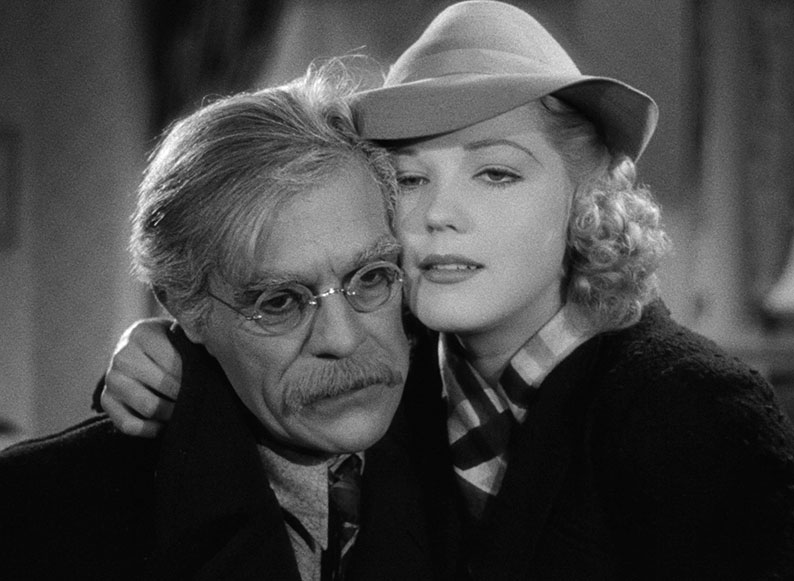
When it comes to the characters and the performances, I found myself in two minds. Karloff is instantly sympathetic in a role he would recycle several times – he even revives David’s look and for Dr John Garth in Before I Hang – and despite her character’s initially woeful naiveté, Jean Rogers makes for a solidly dependable Joan. Although clearly being set up as the romantic lead from the moment we meet him, however, Warren Hull’s Jim initially comes across as a self-satisfied twerp, pushing his way past Joan into her boarding house room that she shares with her father. Joan rightly protests, but Jim just grins and ignores her while he and the equally cocky Mike barge in and conduct what Jim freely admits is an illegal search. Having taken a fancy to her, he then behaves like a predatory stalker, sitting outside her door, following her to work, and at one point even barring her entry to her own home. By now I started wishing that Joan would deliver a swift kick to his testicles instead of gradually falling for him as tradition dictates that she is destined to do. The decision to have Hobart Cavanaugh play Louie as a comedy sidekick also initially had me groaning, in part because his comic antics felt at odds with the tone of the film to that point, but once he and David team up and start raiding shops, I found myself warming to him and their engaging odd couple partnership.
Then, halfway through the film, a new plot strand is introduced that delivers what for me is the best character and performance in the film. With the press all over David’s pranks as the self-styled Night Key of the title, word of his activities reaches a criminal gang leader known as The Kid. He’s played by Alan Baxter, who did tend to specialise in sinister roles, but he’s just sublime here, delivering his lines in an unemotional monotone and a nasal twang, and staying ice-cool in situations in which others would lose their rag. And he’s all the more deliciously intimidating for it. From the moment he coolly delivers his first line – “I don’t know what his racket it is, but a guy with a talent like that should be working for me” – I knew I was going to relish his every appearance, and he doesn’t disappoint. It really takes something to overshadow Karloff by seemingly doing so little, but Baxter nails the role, and the film is all the better for it. It helps that he’s surrounded by a convincingly fearsome looking collection of goons, the most potentially dangerous of whom is known as Fingers (played by John Ford regular, Ward Bond), who dishes out violence at the drop of a knuckle duster and is only prevented from doing worse by The Kid’s calmly controlling words.
One point of particular interest is the technology that is central to the story, being alternately accurate, unlikely, and even forward-looking. The Ranger electromagnetic contact-based alarm system was based on real-world equipment that had been in existence and use for some time, and the main switchboard and address logging system we see demonstrated thus has an authentic feel. Indeed, so large is the alarm detection switchboard – it covers an entire wall and consists of a hundreds of switches and indicator lights – that I did wonder if the filmmakers had simply bought a real system rather than designing and constructing one from scratch. The new invention that David sells to Ranger is one that may have seemed fanciful in its day (and boy, did I spent some ultimately fruitless time researching the timeline on this), but a real-world equivalent did eventually appear in the form of the photoelectric sensor, which did indeed find extensive use in security systems. The device David later rigs up to fire crackles of electricity at the bad guys to immobilize them does briefly moves the film into the realms of Buck Rogers science fiction, which does knock the realism of its improvised construction on the head – if the device had turned out to be the electric cattle prod that all logic was indicating it would be, I’ve had bought it in a heartbeat. Later still, the idea that David could tune his electronic key to a frequency that would shut down the engine of a car is far-fetched in the context of the technology of the day, but all these years later the ability to immobilise vehicles electronically has also come to pass and is even included in some models as a security device, bringing us back to where this story began.
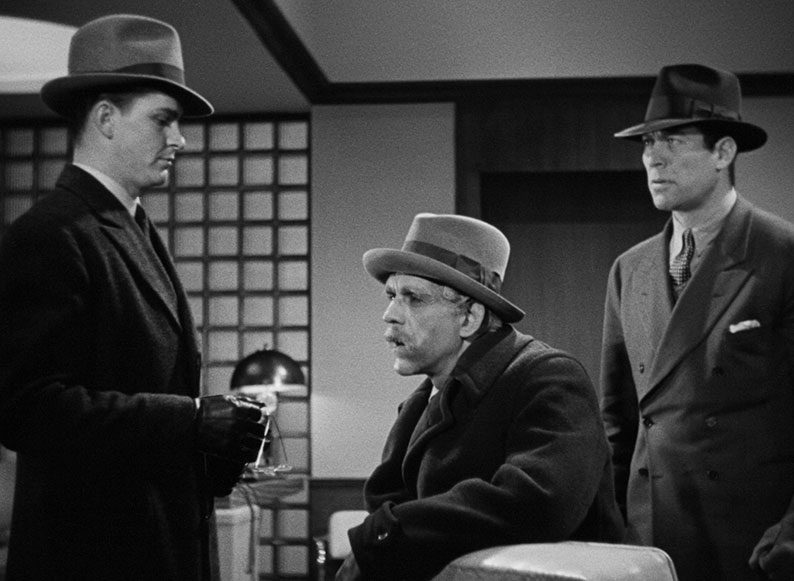
Lloyd Corrigan, a busy actor who also directed 12 features, keeps the pace brisk and occasionally shows a flair for more expressive imagery. My favourite shot sees the camera following Fingers and one of his gangster-dressed associates as they slowly approach the unaware David, the threat they represent beautifully inferred by the framing, the slow speed of their walk, and the smooth movement of the camera. Tristram Tupper and John C. Moffitt’s screenplay does deliver a couple of unexpected twists, including the sort of socially prejudicial sacrifice I’ll have more to say about in a review I’ll be posting later this week of a very different film. Some movie tropes just refuse to die.
Uneven in its storytelling, its characters and even its internal logic it may be, but much of this is par for the B-movie filler course. None of this excuses the terrible ending, which attempts to wrap things up by having a deeply wronged character suddenly forget everything that has happened to him and behave like the world’s most gullible idiot. It also lets the film’s true monster off the hook by suggesting that they’ve somehow learned their lesson and have been transformed by the experience into the sort of wonderful and trustworthy individual they have spent the rest of the film demonstrating they most definitely are not. I can’t help thinking this was cobbled together at the last second when the filmmakers ran out of time or money, but it makes for a tawdry conclusion to a film that, for all its inconsistencies, really deserved better.
Dr Friedrich Hohner (Boris Karloff) works as a physician for the Vienna Royal Theatre, where he is employed to treat the ailments of the theatre’s opera stars and ensure they are all in sparkling health. A morose man, he continues to mourn the loss of the theatre’s lead singer, Marcellina (June Vincent), who mysteriously disappeared ten years earlier. It’s hardly surprising. In a flashback whose edge-of-frame optical effect anticipates the one used for the alien POV shots in Jack Arnold’s It Came from Outer Space (1958), it’s revealed that Marcellina was Hohner’s fiancée, but so tortured was he by the thought of other men feasting their eyes on her and hearing her sing that he insisted that she abandon her career. When she refused to do so and rejected his love in no uncertain terms, he murdered her. What became of her body is left for us to speculate. At least for now.
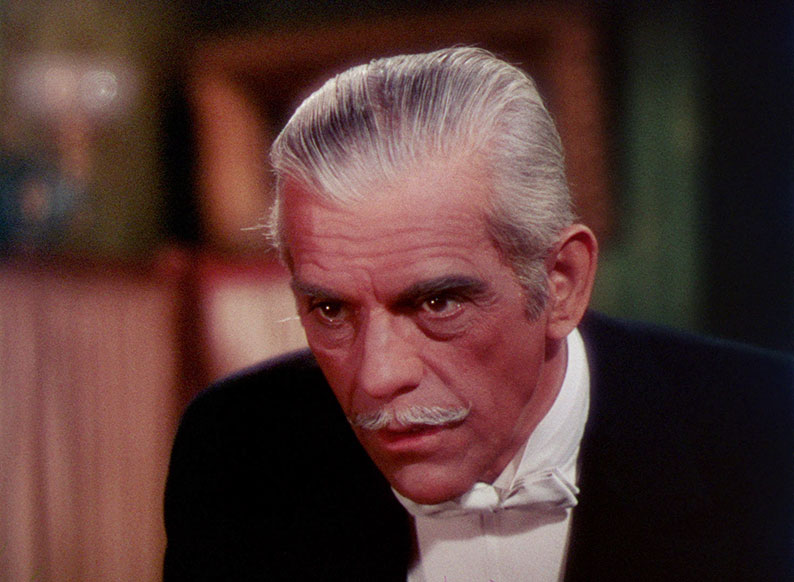
The company’s lead female singer now is Jarmila Vadek (Jane Farrar), a temperamental prima donna whom we first meet as she is angrily complaining to theatre director, Count Seebruck (Thomas Gomez), that the opera’s male lead, Amato Roselli (George Dolenz), placed his hand on her waist while rehearsing a romantic scene. She certainly holds no interest for the still mourning Hohner, but when the doctor overhears music student Angela Klatt (Susanna Foster) singing from The Magic Voice, he loses his rag. “That music is sacred!” Hohner barks at Angela. “Sacred to the memory of Marcellina!” As Hohner departs, the sniffy Jarmila condescendingly tells Angela that she shows some promise, but Seebruck is impressed enough to cast her in the lead role of a production of The Boulevardier being staged the following week. Angela’s debut is a roaring success, and as she emerges from the theatre that evening, she is met by Hohner, who informs her that it is his duty to examine the throats of the singers after they perform. To this end, he leads her to the suite in which he lives with his Mrs Danvers-like housekeeper Luise (Gale Sondergaard), where he reveals to Angela that Seebruck is planning a revival of The Magic Voice with her in the lead. He then sits her down and hypnotises her, implanting in her mind the belief that she never wants to sing again.
Okay, confession time. I try not to let issues of personal taste influence my reviews, but I can’t dodge round it here and might as well lay my prejudicial cards in the table. I’m not a fan of opera, and while I can tolerate it in small doses, that high-pitched, glass-shattering female soprano stuff really sets my teeth on edge. And there’s a lot of it here. Whole numbers are performed when the song’s role in the story requires just a few seconds of screen time, sending me scrabbling for the volume control and creating the impression that The Climax was intended as an opera-themed romantic musical onto which horror-thriller elements have been grafted. It even has the look of a Hollywood musical, thanks in no small part to W. Howard Greene and Hal Mohr’s lush Technicolor cinematography, and Alexander Golitzen and John B. Goodman’s handsome art direction.
Those who know their classic horror titles will doubtless have already twigged that, despite being based on a play of the same name by Edward Locke, the setup of The Climax is a partial inversion the plot from Gaston Leroux’s much filmed The Phantom of the Opera. Cementing this connection is the recycling of sets constructed for the previous year’s film adaptation of the novel, whose feted singer Christine DuBois was played by none other than Susanna Foster, who is effectively cast in the same role here. Indeed, The Climax was originally planned as sequel to Phantom of the Opera, which effectively casts Karloff as a substitute Erik, but instead of being cursed with a facial deformity, he is haunted by a terrible crime from his past. At no point is he looking for a replacement for his lost love, however, and he is never of the opinion that the talented Angela would be able to take her place.
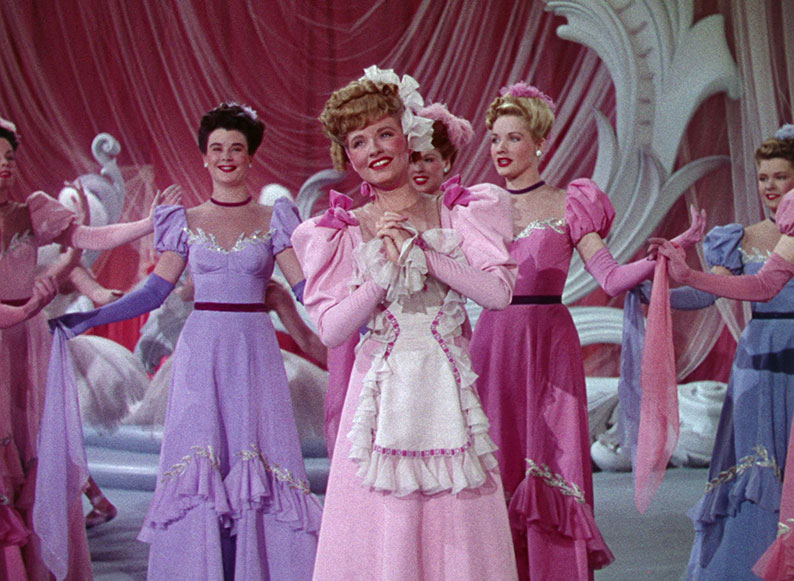
All of which justifies the opera performances, but if you somehow share my reaction those long-held, eardrum-bursting busting high notes, that’s not going to help here. It probably wouldn’t matter as much if I cared more for the lead characters, but despite being decently performed, I failed to really engage with any of them. That said, I did appreciate the fact that Roselli is played by an Italian actor, and that his accent is thus authentic and not overplayed for comic effect (see the opening scene of Night Key for a prime example of that). Karloff is suitably menacing when he’s on screen, but really does feel like a supporting player here, with his scheming against Angela always playing second fiddle to the cutesy romance between the two leads and the operetta performances that feel like the film’s true raison d'être. The Wolf Man and Man Made Monster director George Waggner seems to have enjoyed staging the musical numbers but does tend to shine brightest when working with Karloff in sinister mode – the eerie hypnotism sequence is probably my favourite in the film, and the huge soft-focus close-up of Karloff’s eyes as he plants commands in Angela’s mind may be the film’s most unexpected and creepy shot. As a whole, the film certainly has its pleasures, most of which occur when Karloff is on screen, but I did find myself recalling Tony Rayns’ retrospective review of the 1942 Leroux adaptation to which this was an originally planned sequel – “Too much opera, not enough phantom.”
Now we’re talking. The 1952 The Black Castle has not only the best opening scene of any film in this set, but one of the finest of any film I’ve watched so far this year. At the doorway to the basement of the spooky-looking castle of the title on a dark and stormy night, a man named Fender (Henry Corden) throws a rock at a wolf that is howling at the gate. He then steps inside, where he and his companion Koppich (Bernard Szold) continue the task of sealing up a coffin. Koppich is creeped out by the fact that the eyes of the dead man remain open. “It’s almost as if he were alive,” says Fender. Cut to a huge close-up of the dead man’s immobile face, and suddenly we hear his thoughts as he pleads into the abyss, “Of course I’m alive! Fender, Fender, help me! You’ve got to help me! I’m not dead!” But Fender doesn’t hear this, and it’s then that we realise there are two coffins. “The woman looks dead enough,” observes Koppich. “She was always nice to me,” notes Fender. “Not like the Count.” A subtle bit of introductory exposition there. As the paralysed man continues with his silent pleas, Fender recalls that he warned him even before he reached the castle, but that he just wouldn’t listen. As Fender and Koppich begin the process of sealing the coffins for burial, the paralysed man looks back at the events that brought him to this point. It’s a hell of a hook, and is immaculately handled, particularly the close-ups of the supposedly dead man’s frozen face as he realises that he is powerless to prevent a terrible fate.
As we flashback a few weeks, the paralysed man of the opening is introduced to us as Sir Ronald Burton (Richard Greene) as he arrives at the office of the English minister at the court of Emperor Charles VI in Vienna, Sir David Latham (Leslie Denison). Burton is on a quest to discover what happened to his two closest friends, whom he believes have fallen foul of a powerful aristocrat named Count Karl von Bruno (Stephen McNally). To aid his investigation, the emperor himself has secured an invitation for Burton to join a scheduled hunt on von Bruno’s Black Forest estate, one he will attend under the alias of Richard Beckett. It’s a long journey that Burton undertakes with his trusted servant, Romley (Tudor Owen), in a coach being driven by none other than Fender, the man shown glumly sealing Burton’s coffin the opening scene. They stop off for the night at the Green Man Inn, from where a final communication was sent to Burton by his now missing friends. Here, Burton invites the humbled but grateful Fender to join him and Romley for a meal, which is disrupted when two self-important aristocratic toads named Count Ernst von Melcher (Michael Pate) and Count Steiken (John Hoyt) slap Fender’s food from his hands and demand that the table be given over to them. Unaware of Burton’s true identity and that he is a former soldier of some note, they are quickly relieved of their swords and sent on their way, with Steiken left nursing a cut to his arm. Fender warns Burton that the two men are close friends of Count von Bruno, and that it might be wise of him to turn back, a suggestion that Burton cheerfully dismisses. Well, as Fender noted in the opening scene, he did try to warn you…
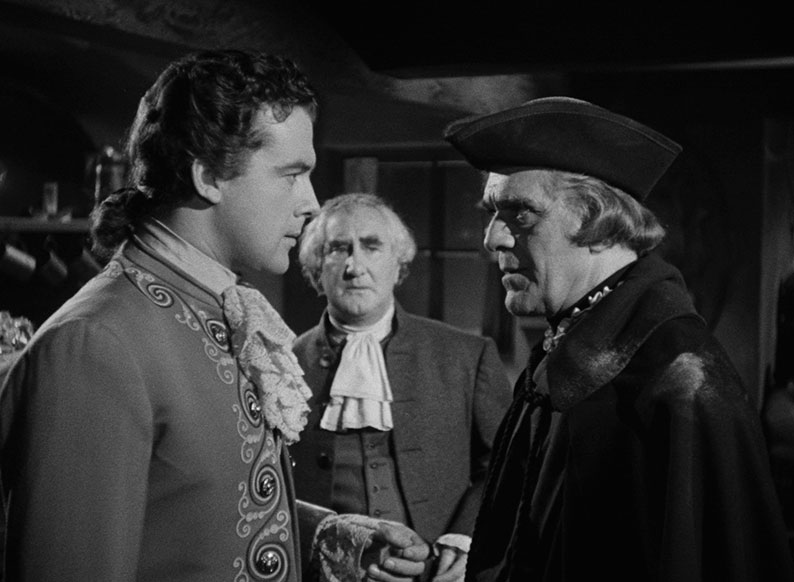
When Burton arrives at Count von Bruno’s castle under the guise of Richard Beckett, he discovers that the Count already has guests in the shape of von Melcher and Steiken. Steiken’s wound is being treated by von Bruno’s personal physician, Dr Meissen (Boris Karloff), who seems to be rather enjoying inflicting considerable pain on his patient. On the Count’s unspoken but clearly inferred orders, the hatchet is buried, and Burton is welcomed to the castle, then informed by his host that the hunt in which he has come to take part in will include stalking a leopard that he has had imported from Africa. It’s actually a black panther, but I’m not going to split hairs when the leopard is a big cat of the genus Panthera. And yes, I did have to look that up. When Burton heads off to his designated room, von Melcher says to von Bruno, “I think you made a mistake bringing the Englishman here, Karl,” to which von Bruno ominously replies, “It would have been a bigger mistake to refuse the emperor’s request. That alone would have aroused his suspicion. No, Mr Beckett will serve his purpose.” Although still determined to uncover what happened to his friends, Burton finds himself increasingly bewitched by von Bruno’s attractive new young wife, Elga (Paula Corday), but seems unaware that von Bruno’s hulking and mute manservant, Gargon (Lon Chaney Jr), is regarding him with a look that borders on recognition.
If you thought Karloff’s role in The Climax felt more like a supporting one, just you wait until the first half of The Black Castle. His first appearance as Dr Meissen is so brief that were it not for the fact he is played by Karloff, you’d be forgiven for presuming we’d never see him again. Indeed, he’s only on screen here for a total of 46 seconds (I counted), and it’s another 18 minutes before he makes a second appearance. Even then, it’s just to watch meaningfully from the sidelines during an evening ball, or to skulk behind a pillar when Burton makes his first serious move on the countess and reveal to her the true purpose of his visit. When another potential eavesdropper to this conversation falls into a drunken stupor and dies, however, the small, satisfied smile that breaks onto Meissen’s lips as he examines the body suggests that he may have engineered the man’s fate. It’s a suspicion underlined by his ‘accidental’ breaking of the bottle from which the man was drinking, indicating that he’s due to play a more significant role as the story unfolds, though by this point we’re 47 minutes into an 82-minute film.
The difference here, at least when compared to his role in The Climax, is that while Karloff is at his most subtly effective here as Dr Meissen and the film would definitely be poorer for his absence, it would still be a compellingly performed and handsomely mounted slice of gothic-toned mystery horror. Richard Greene makes for a lively and engaging hero, and he’s matched at every turn by Stephen McNally’s splendidly self-satisfied and sadistic Count von Bruno, a deliciously nasty aristocratic villain in the mould of Peter Wyngarde’s John Cleverly Cartney in the notorious A Touch of Brimstone episode of The Avengers. John Hoyt and (especially) Michael Pate are suitably unpleasant without overstatement as von Bruno’s sidekicks Steiken and von Melcher, and while it’s somewhat disappointing to see a once great horror star consigned to a dialogue-free supporting role, Lon Chaney Jr is still an intimidating presence as hulking mute Gargon. As Countess Elga, Rita Corday is suitably alluring, but I’m definitely with Kim Newman and Stephen Jones (see the commentary below) in wishing that more screen time had been given to Nancy Valentine’s Therese Von Wilk, a wily seductress who whose taste for the hunt make her a match for any of her male companions. There’s also a very nicely pitched performance from Henry Corden as Fender, one that brings humanity and a little depth to a character that could easily have been little more than background decoration – we learn more about him from his touchingly believable reaction to the meal offered to him by Burton than anything he says or that is said about him.
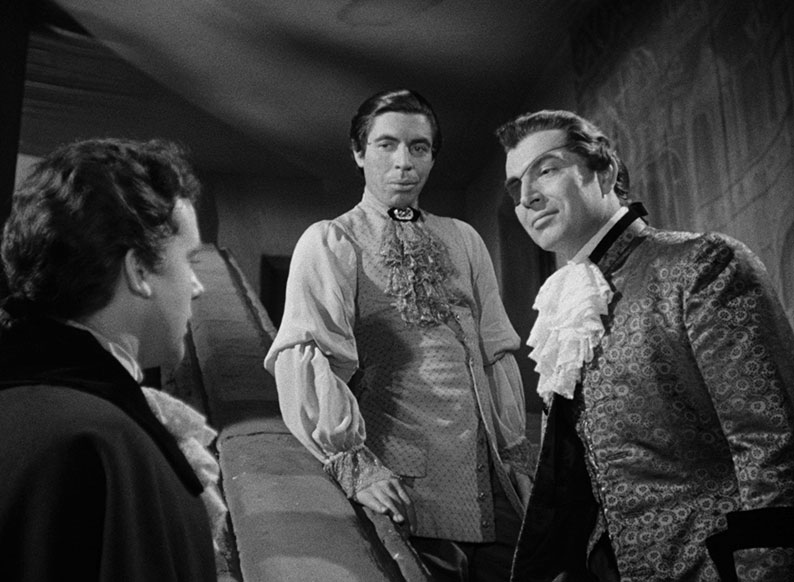
The Black Castle was the directorial debut of former art director Nathan Duran, a name genre fans will likely be most familiar with for his later collaborations with Ray Harryhausen, 20 Million Miles to Earth (1957), The 7th Voyage of Sinbad (1958) and First Men in the Moon (1964), though for many he will forever be immortalized for directing (under the pseudonym Nathan Hertz) the 1958 cult favourite Attack of the 50 Foot Woman. Nothing about his handling here betrays his first-timer status (he apparently credits his collaborators with really helping him), with his camera placement always on point, enhanced by Irving Glassberg’s expressive framing and moody monochrome lighting. There are times when the film has the atmosphere of one of Roger Corman’s later Poe adaptations, and there’s a nastiness to von Bruno’s gleeful sadism – while often implied rather than shown – that intermittently gives it the feel of a work made a good ten years after its true production date. There are enough twists in Jerry Sackheim’s screenplay to keep you guessing how the plot will end up where it began, including an escape attempt that unexpectedly plonks the escapees right back where they started, and while the finale is jarringly abrupt and has more than a whiff of deus ex machina about it, the simple fact that it comes out of nowhere still gave me a brief frisson of surprised satisfaction. Individual lines and exchanges impress, but my favourite comes when an imprisoned Burton says to von Bruno defiantly, “I can expect the worst from you,” and the testily gloating von Bruno replies, “Then you won’t be disappointed!”
The 1080p transfers of Night Key and The Black Castle are presented here from 2K scans of fine grain film elements, while The Climax is presented from a 2K scan of an interpositive. I’m guessing that all three were supplied by Universal, whose logo heads up both of the discs in this set. While none of the transfers is quite reference quality (Eureka’s Blu-ray of Fritz Lang’s M is still a standard-setter on this score), all three still display crisply defined detail (in one exterior scene in Night Key, the breath of the characters is clearly visible as they speak), attractively graded contrast, solid black levels, and that almost indefinable quality you only get from 35mm film. A fine film grain is visible on all three transfers, and all are clean of dirt and obvious signs of wear. Night Key and The Black Castle were both shot in black-and-white, and on those transfers it’s the greyscale that matters, and it’s nicely rendered in both. The Climax, on the other hand, was shot in Technicolor, and has the rich, almost other-worldly look to the colour that was common on Technicolor works of the period, with the primes in particular vividly reproduced. All three are presented in their original 1.37:1 aspect ratio.
All three films have Linear PCM 2.0 mono soundtracks, and while the expected restrictions in dynamic range are evident, dialogue, effects and music are all clearly rendered, with no sign of any damage or serious wear. There is a very faint background hiss audible on Night Key and The Climax if you crank the volume up, but at normal listening level it’s hardly noticeable. As the most recent of the films, The Black Castle is free of any trace of hiss or fluff.
Optional English subtitles for the deaf and hearing impaired are available for all three films.
This is a two-disc set, with Night Key and The Climax on disc 1 and The Black Castle on disc 2. The special features are all film specific.
NIGHT KEY
Audio Commentary by Kevin Lyons and Jonathan Rigby
The first of two commentaries in this set by the regular pairing Encyclopaedia of Fantastic Films and Television website editor Kevin Lyons and English Gothic author Jonathan Rigby follows the pattern of their previous collaborations by being a blend of personal opinion and meticulously researched background details. They’re clearly fans of the film, championing the performances and the effectiveness of the comedy (we’ll beg to differ just a little on that last one), but they also provide a useful breakdown of its development and production. They’re every bit as impressed as I was with Alan Baxter’s performance as The Kid, and highlight the science fiction elements, note that this was a new type of role for Karloff, and slam the ‘unbelievable’ ending. They also provide an interesting look at why the film was mislabelled as horror for many years. It’s fascinating stuff, though I was surprised by their gentle mockery of the workings of the Ranger alarm system because it involved looking details up in a physical file. I’m sure I don’t really need to point out that before the advent of computers, this is how such things were done, and in its day, this would have been regarded as the height of efficiency.

Trailer (1:38)
An uninspiring trailer that attempts to link the film to the role that brought Karloff to fame with an up-front title card asking, “Is another Frankenstein abroad?” Another informs us that “Karloff puts science to a new use,” seemingly forgetting that he played The Creature and not Dr Frankenstein in the movie that the trailer is referencing.
There are two Stills Galleries. The first, Production Stills, has 36 crisply rendered promotional photos, most (if not all) of which are posed, including a particularly static one of a blow being delivered by one character to the chin of another (I could almost hear the photographer shouting, “Hold it, just there!”). Artwork and Ephemera consists of nine screens of posters, including a couple of international ones.
THE CLIMAX
Audio Commentary by Kevin Lyons and Jonathan Rigby
The second commentary by Lyons and Rigby follows the tone and pattern of the first, being a mix of opinion and background information on the film. It becomes clear from an early stage that they enjoyed this one more than I did, though Lyons does feel there is too much opera, and when summing up they describe it as pictorially beautiful and a little confused but note also that it does have its pleasures. Fair enough. The connections to the 1943 Phantom of the Opera are established early on, and comparisons to it are made throughout, with the opinion being that The Climax is the better film. Contemporary reviews for the film are quoted from, it’s noted that this was the first time audiences would have seen Karloff in colour, and Lyons has a real beef with how hypnotism is portrayed in cinema compared to how it is used in real life. There’s lots more here of considerable interest.
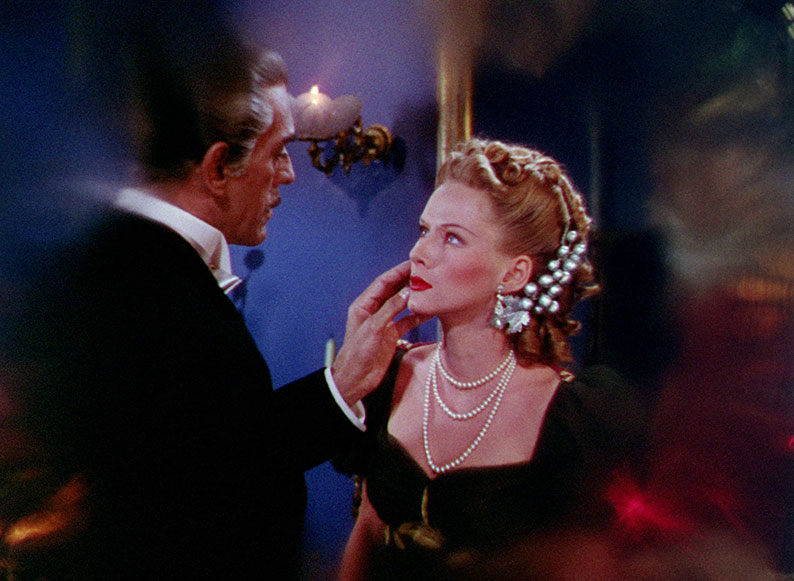
Trailer (2:07)
“From the studio that created Phantom of the Opera,” barks an opening caption that makes no attempt to hide the key influence on what was originally intended as a sequel. It then champions both its horror and its musical credentials and makes great play of its cast, and the fact that it is “in magnificent Technicolor.”
Again, there are two Stills Galleries. Here, Production Stills has a generous 67 screens of impeccable quality promotional photos – honestly, these are all amazing in their sharpness and pitch-perfect contrast. Artwork and Ephemera has 10 screens of posters, artwork, a single lobby card and a VHS video cover.
THE BLACK CASTLE
Audio Commentary with Stephen Jones and Kim Newman
Genre writers Stephen Jones and Kim Newman get to grips with my favourite of the three films in this set, and both make some really interesting observations, with Newman noting that the character of Burton may well have been inspired by famed explorer Richard Burton, and that the film has many of the elements of a James Bond movie. That may seem like a stretch, but he makes a convincing case, and notes that this film was released just a year before the first Bond novel was published. We get information on the actors, director Nathan Juran and producer William Alland, and commentary on the effectiveness of particular scenes, including particular praise for first-time director Juran’s handling. They also make several comparisons to the 1951 The Strange Door, in which Karloff stars with Charles Laughton, and admit to doing so in part because they have just finished doing a commentary for that film. Have they just inadvertently revealed one of the films from another yet-to-be-announced Eureka Karloff box set?
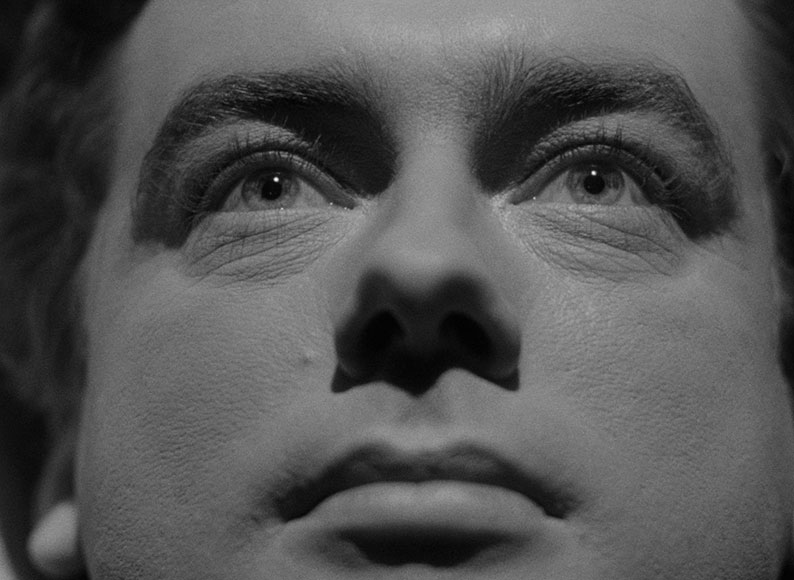
Once again, there are two manually advanced Stills Galleries. Production Stills consists of 67 screens of high quality on-set and posed-against-a-blank-wall promotional photos. Artwork and Ephemera has 18 screens of posters, poster artwork, lobby cards, and a single VHS video cover.
Also included with the first 2000 copies is a Limited Edition Collector’s Booklet featuring new writing by Karloff expert Stephen Jacobs (author of Boris Karloff: More Than a Monster), but this was not available for review.
A varied and uneven three-film collection perhaps, but for Karloff devotees this is still a must-have, and comes warmly recommended anyway for The Black Castle alone, though I have a feeling that Night Key will grow on me more with subsequent viewings. Whatever your opinion of the individual films, the transfers are first rate, and the commentary tracks are excellent, which in my view still makes this a most worthwhile release.
|